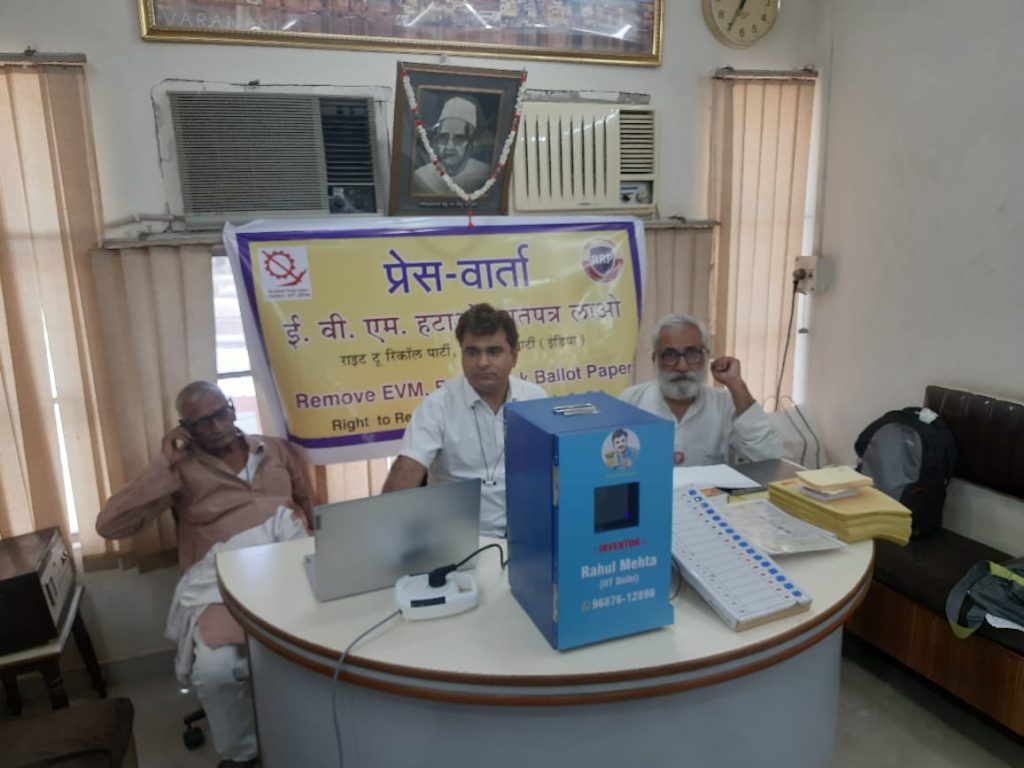Rohit Seth

Remove EVM, Bring back Ballot Paper
A Indian Institute of Technology, Delhi and New Jersey trained engineer Rahul Mehta, who also runs a political party by the name of Right to Recall Party, has designed a machine where he demonstrates how the black glass, introduced in 2017, hides the way in which votes are stolen by EVM and VVPAT combine. A voter when casts her vote will be able to see the symbol in VVPAT to which she has voted. But while every vote to the preferred symbol is printed as a separate slip inside VVPAT, for consecutive votes to any other symbol only the first vote is printed, shown to the remaining consecutive voters by light bulb which goes on for 7 seconds inside the VVPAT for each voter and rest of the votes are printed as the preferred symbol. This is how the machine has been programmed. To make the preferred symbol win the election by stealing votes from other candidates.
Now Rahul Mehta is not claiming that this is what actually happens in the EVM-PPVATs used by the Election Commission of India but he is just demonstrating a possibility of how votes can be stolen if somebody decides to do that. Neither is he claiming that this is being done everywhere. But if the ruling party wants, with the help of sympathetic computer programmers, systems managers and officials, it can manipulate the machines in some constituencies, especially where it fears losing by small margins.
There are a range of voices against EVM and proposed alternatives. Right now only five booths in an assembly constituency, which has roughly 300 booths, are randomly chosen to tally the figures from EVM and VVPAT. Some people demand the 100% counting of VVPATs should be done and tallied with EVM figures. However, Rahul Mehta’s contraption shows that votes can be manipulated in both the EVM and VVPAT and can perfectly tally without revealing that votes were stolen from candidates who stand opposite to the preferred party candidate. Some others suggest that VVPAT slips should be handed over to the voter who then should deposit it in a box which has no electronic chip and these slips should be counted. Now, if we’re going to count slips printed by VVPATs collected in an ordinary box, we might as well count the ballot papers after they have been stamped by the voter and deposited in a ballot box. What is the need to keep the EVM-VVPAT between the voter and the paper slips/ballot paper? EVM-VVPAT really becomes redundant in this case serving no purpose like efficiency or quick results for which it was brought in, in the first place.Hence it appears that bringing ballot papers back for assembly and parliamentary elections is the most wise solution. The local bodies’ elections are anyway held with ballot papers. This implies that bureaucratic machinery to conduct polls with ballot papers is already in place. And we do print ballot papers even in assembly and parliamentary elections for government employees who have to vote through postal ballots and senior citizens above 85 years of age who vote from their homes. Hence all we need to do is to print ballot papers in larger numbers. A number of countries, including developed ones, have gone back to ballot paper. The argument against ballot papers that they too could be stolen holds less weight now with the availability of cameras. In the Chandigarh Mayoral elections fudging of ballot papers was caught on the camera. Had the same thing been done through the EVM-VVPAT it would not have been caught as what happened inside the machine is hidden from everybody, including the unsuspecting officials overseeing the polls.
Press conference addressed jointly by Pavan Kumar of candidate at Bhilvada Loksabha constituency from Right to Recall Party and Sandeep Pandey vice president Socialist Party (India).


